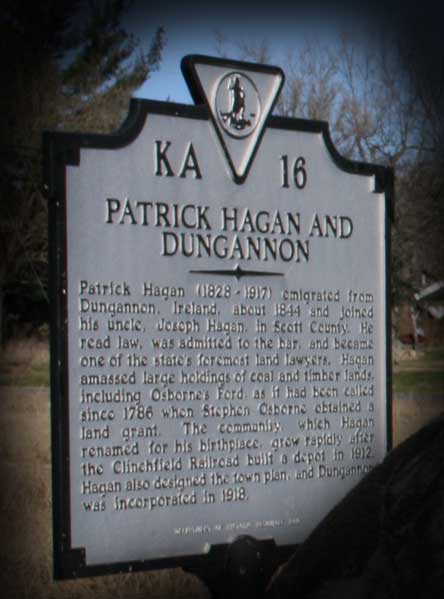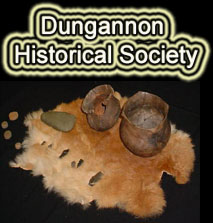| 
Osborne's Ford like most other communities in the southern
mountains, was settle by Scotch-Irsh and English immigrants who traveled
here from North Carolina in search of land.
The settlers were largely self-sufficient until the Twentieth
Century brought industrialization. Not only did this alter the way of
life, but it changed the name of the community itself, from Osborne's
Ford to Dungannon.
The coming of the railroad, timbering and coal mining created a "boom
town" atmosphere until World War I. Though family farms continued
to provide a subsistance for many, men began seeking "paying jobs"
outside this rural community. By World War II, migration to urban centers
became predominant. The migration of young people continues today.

A
Project of
Dungannon Development
Commission, Inc.
|
|
| 6,000 B.C. |
Indians camped on Clinch River. |
| 1,000 A.D. |
near site of Dungannon. |
| 1,000 A.D. |
Indians lived in Village near Hunter's Ford (now Dungannon). |
| 1763 |
End of French and Indian War. Prior to this the Clinch Valley
was claimed by the French. |
| 1763-1783 |
The Clinch Valley was designated Indaian Territory by the
British. |
| 1770's |
Long hunters and explorers travel through the area on Hunter's
Path, crossing the Clinch River at Hunter's Ford. |
| 1772 |
Patrick Porter settled on West Side of Fall Creek near present
day Dungannon. He built a fort and grist mill. |
| 1770-1794 |
Numerous Indian attacks on early settlers in the area. |
| 1774-1795 |
Moore's Fort at Castlewood was operated to protect early
settlers. |
| 1774 |
Daniel Boone commanded Moore's Fort and Fort Blackmore. |
| 1777 |
Indians captured Polly Alley, near present site of Dungannon
and took her to Ohio She escapes and returns. |
| 1782 |
Stephen Osborne surveyed land and settled at Hunters Ford
which later became known as Osborne's Ford. |
| 1786 |
Gov. Patrick Henry signed deed for Stephen Osborne's track
of land at Osborne's Ford. Osborne;s Ford became a trading center for Clinch
River settlers. |
| 1832 |
Daniel Ramey established a ferry at Osborne's Ford. |
| 1833-1839 |
Joseph Hagan bought land in area including Sulphur Springs
and Hunter's Valley. |
| 1860's |
Patrick Hagan, nephew of Joseph Hagan bought land from William
Robinson and built Hagan Hall at Sulphur Springs . |
| 1909 |
The railroad reached Osborne's Ford and the town was renamed
Dungannon by Patrick Hagan for his home in Ireland. |
| 1918 |
Dungannon was incorporated as a town. |
| 1913-1924 |
Dungannon was centered for timber shipping form lumbering
in the area. Small coal mines were operated near Little Stoney Creek. |

